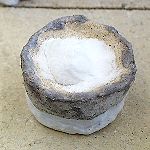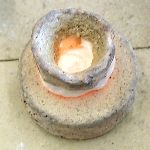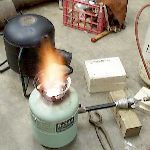| |
 |
 |
 |
 |
-GURU
|
 |
This is an experiment I ran to test the effectiveness of coating
Kaowool with
ITC-100 and the resulting
borax flux resistance.
Kaowool, Cerrablanket, Inswool, INS board are all similar light weight ceramic refractories used to build
forges, furnaces and kilns for blacksmiths, potters and others.
They all surfer from being eaten by flux.
Borax flux goes through Kaowool like a hot poker in styrofoam.
It attacks other refractories as well but not to this extreme.
This reduces the insulation efficiency and these refractories are relatively expensive so the damage is not to be taken lightly.
It is commonly recommended to coat these refractories with ITC-100 to reduce mechanical damage and prevent the creation of possibly hazardous airborne dust.
The ITC coating absolutely prevents the creation of dust and helps protect from mechanical damage but is limited in what a thin coating 1/32" to 1/16" (~1mm) can do.
The question of flux resistance came up and there were no good answers. So I devised the following test. . .
|
 |
 |

Figure 1
Click for Detail |
Recently I have built a couple little melting furnaces out of old freon cylinders that take a 1# crucible. They are lined with Kaowool. The advantages of the Kaowool being it is fast and easy to build with and I can easily pick up this little furnace with one hand.
The problem is that hole in Figure 1 that looks like someone urinated in fresh snow.
|
 |
 |

Figure 2
Click for Detail |
This hole is the result of part of a pinch of borax flux missing the crucible. Just a few grains ate a that one inch hole that is 3/4" deep. It also glazed the firebrick furnace bottom. This was damage from only the second firing. Kaowool is light and easy to work but it is not cheap.
|
 |
 |

Figure 3
Click for Detail |
To repair the damage I picked out the contaminated Kaowool and coated the surface of the hole with ITC-100 and stuffed a scrap of kaowool in the hole.
Afterward I coated the entire interior of the furnace. I left the top surface uncoated as a soft gasket surface for the lid.
But the big question is, WILL the ITC-100 protect the Kaowool from flux damage?
|
 |
 |

Figure 4
Click for Detail |
I took a 2" (50mm) diameter plug of 1" (25mm) Kaowool left over from cutting the furnace vent and pinched up a little melting bowl shape.
|
 |
 |

Figure 5
Click for Detail |
Then I coated the bowl with ITC-100 as shown.
The ITC-100 was applied with a small 1/2" (13mm) artist's brush.
I work directly from the jar adding a little water and making a slurry with the brush.
Three thin coats were applied, firing the bowl between coats.
After the first coat is fired the ITC-100 is much easier to apply because you have a hard non-absorbent surface.
|
 |
 |

Figure 6
Click for Detail |
The bottom of the bowl was left uncoated so that it would be easy to see the results of the test.
A large lump of 20 Mule Team Borax was put in the bowl.
|
 |
 |

Figure 7
Click for Detail |
The ITC-100 lined Kaowool bowl full of borax flux was put in the furnace and fired.
|
 |
 |

Figure 8
Click for Detail |
After the flux had melted down there was not much so another lump was added and also melted down. The furnace was fired at high temperature for about 10-15 minutes with the lid on. All the photos here are with the lid off.
That is a Kaowool bowl full of molten borax flux!
|
 |
 |

Figure 9
Click for Detail |
After firing for a time the bowl was removed while hot and the flux poured out.
What I did not expect was how soft the thin ITC-100 crust would get at high temperature. I slightly crushed the bowl and cracked one side (arrow).
Otherwise there was no apparent damage to the Kaowool from the flux.
|
 |
 |

Figure 10
Click for Detail |
One interesting note was that the hardened flux from the bowl was crystal clear. This is an indication that it did not disolve anything.
|
 |
 |

Figure 11
Click for Detail |
I patched up the bowl with ITC-100 and fired it again.
The used bowl had a glaze of flux inside and a large bead on the lip where I had poured out the flux from the first firiing.
It was only fired long enough to bring everything up to a yellow heat.
|
 |
 |

Figure 12
Click for Detail |
The interior of the bowl held up well but the flux permeated the fresh coat of ITC-100 from underneath.
The flux bead on the side of the bowl melted and ate a large hole in the Kaowool.
Flux from the cracked interior wetted the underside of the bowl and the lump of Kaowool was eaten 75%.
It is hard to tell from this photo but it is like a creme puff with no filling.
A small amount of flux melted all the way through to the bottom.
|
 |
- GURU
|
 |
Initial Conclusion: ITC-100 does protect Kaowool from borax flux.
However, any cracks or holes where the surface is wetted by flux can result in a lot of damage.
This is something to consider carefully before using flux in a Kaowool or INS board lined forge or furnace. You want to use the ITC-100 before you contaminate the forge lining.
The repair in my furnace seemed to hold up. Two thin coats of ITC-100 on the firebrick absorbed or sealed the flux glazing the brick. However as you can see from the damage to the test bowl you can have damage behind the hard ITC-100 crust and not know it.
NOTE: This was a short non-conclusive test.
I am going to make another test bowl and run a second test.
This time I will not try to pour out the flux and I will fire it for a measured time, say 2 hours.
This is long enough for the furnace to get up to maximum temperature and for the flux to have time to disolve through the ITC coating if it can.
The second test will be reported here as soon as I complete it.
|
- GURU
|
 |
TEST 2:
|
 |

Test 2 Figure 1
Click for Detail |
A second melting bowl was prepared as was the first above.
It was slightly smaller.
Three thin coats of ITC-100 were applied, firing after each coat.
It was then filled with hydrated borax (20 Mule Team Borax) as shown.
|
 |
 |

Test 2 Figure 2
Click for Detail |
The bowl was then fired in the crucible furnace.
The plan was to fire the bowl for 1 to 2 hours.
But this is what was found after 1/2 hour.
Photographed while still hot setting on the crucible block.
The borax had eaten through the bottom of the bowl and instantly through the Kaowool
|
 |
- GURU
|
 |
Final Conclusion
Although the ITC-100 protects Kaowool to some degree it is attacked by large amounts of borax in a short time.
Small quantities of borax flux blown around in the forge that would do severe damage to uncoated Kaowool
will probably be insufficent to eat its way through a good heavy coating of ITC-100.
Thus it does provide valuable protection greater than its cost.
These results were disappointing but they provided an answer to a question.
Similar tests with other products will be run at a later date.
NOTE: This was an extreme test and IS NOT a recommended method of manufacturing a melting bowl.
|
 |
|
|
 |
|
 |
 |

Figure 13
Click for Detail |
The Crucible Furnace:
The testing furnace is the little melting furnace I built
from a disposable freon tank. It has a fire brick floor in the
bottom (1/2 a brick) and is lined with Kaowool and ITC-100.
It accepts a #1 crucible that will hold 3.2 pounds of brass.
Once heated up it will melt brass about as fast as you can feed it and pour it.
We poured about 12 pounds of brass with one like it in one afternoon.
|
 |
- GURU
|
 |
The big advantage to this little furnace is its light weight.
I can easily hold it with one outstreatched arm.
When I have built another burner and bracket we will have an article on its construction and use.
|
 |
 |
- GURU
|
 |
Questions and Comments from Initial Demo
|
 |
Brogan
|
 |
Good to know that the ITC-100 gets soft when heated
|
 |
- GURU
|
 |
It doesn't actually get very soft but like any material at high temperature it loses strength and is not nearly as hard as at room temperature.
|
 |
Pete F
|
 |
Thanks for fluxing up your Kaowool so we can save ours Guru!
|
 |
Jim C.
|
 |
Would you recommend coating a forge line with castable refractory?
|
 |
- GURU
|
 |
Jim the ITC-100 makes a hard non-chalking coating when applied to brick and castable. The ITC-100 has a high Infrared reflectivity and is said to improve the efficiency of forges and furnaces raising the maximum temperatute.
However hard refractories are not so suseptable to flux damage as the light weight blanket and board products like Kaowool and INS board.
|
 |
chopper
|
 |
Guru , any idea if it's sold down here in OZ ?
|
 |
- GURU
|
 |
Chopper, The ITC products are made by one small US company.
I'll ask if they have any distributors in Australia.
I can ship there but you know the costs and time involved.
Distributor for ITC products in Australia:
Pinches Alloy
Brisbane and Melbourne
07 32729388
A bit of research by Huge McDonald for a similar product.
R.T.Z.
Mathews Industrial Products P/L
58 Gordon Rd
Osborne Park
Western Australia 6017
Phone (08) 9242 1800
R.T.Z. Costs about $A30 per litre.
|
 |
Ntech
|
 |
Thanks for the testing. I like the enlargable images that show more detail.
|
 |
Fred
|
 |
Thank's Jock for the research, Please include a picture shown last nite of the furnace. Cute one as I recal thinking of building one myself a small one might do untill I build a biger one. Details on burner?
|
 |
Brogan
|
 |
As I recall there are other ITC products thst coat/protect. Are you Familiar with them?
|
 |
- GURU
|
 |
Brogan, Since we are setting up to sell ITC products I am testing a variety of them.
In the furnaces I have recently built I used ITC-213 to prime and protect metal. ITC-100 as glue to lamiate Kaowool and I have some ITC-200 patching compound to test on a furnace I built with castable refractory and messed up the bottom.
There will be articles posted on the construction of these furnaces as well as the burners as soon as I have completed a few more details.
|
 |
Jim C.
|
 |
Jock: Very interesting and worth while demo. Thanks; looking forward to more about ITC products.
|
 |
Brogan
|
 |
Thanks for doing all the "leg-work"!!
|
 |
- GURU
|
 |
We will also be selling a reinforcing kit for large forges with INS board roofs. They all have a habbit of sagging from the heat and need to be attached to the steel lining better. I just sold the first today and want to get feed back from the user.
|
 |

